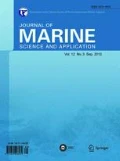Abstract
The navy and other Department of Defense organizations are increasingly interested in the use of unmanned surface vehicles (USVs) for a variety of missions and applications. The term USV refers to any vehicle that operates on the surface of the water without a crew. USVs have the potential, and in some cases the demonstrated ability, to reduce risk to manned forces, provide the necessary force multiplication to accomplish military missions, perform tasks which manned vehicles cannot, and do so in a way that is affordable for the navy. A survey of USV activities worldwide as well as the general technical challenges of USVs was presented below. A general description of USVs was provided along with their typical applications. The technical challenges of developing a USV include its intelligence level, control, high stability, and developmental cost reduction. Through the joint efforts of researchers around the world, it is believed that the development of USVs will enter a new phase in the near future, as USVs could soon be applied widely both in military and civilian service.
Similar content being viewed by others
References
Corfield SJ, Young JM (2006). Unmanned surface vehicles-game changing technology for naval operations, Ch.15 in Advances in Unmanned Marine Vehicles. Institution of Electrical Engineers, 311–328.
Ebken J, Bruch M, Lum J (2005). Applying UGV technologies to unmanned surface vessels. SPIE Proc. 5804, Unmanned Ground Vehicle Technology VII, Orlando.
Enderle B, Yanagihara T, Suemori M, Imai H, Sato A (2004). Recent developments in a total unmanned integration system. AUVSI Unmanned Systems Conference, Anaheim, CA, USA.
Liu TJ, Liu WY (2008). The USV of Spaceflight Xing Guang to the Olympic game with science and technology. The Management of Spaceflight Industry (Chinese edition), 8, 46.
Maguer A, Gourmelon D, Adatte M, Dabe F (2005). Flash and/or flash-s dipping sonars on Spartan unmanned surface vehicle (USV): A new asset for littoral waters. Turkish International Conference Acoustics, Istanbul, Turky.
Niu YF, Shen CL, Dai B, Xu X, Xiang XJ (2009). The development of unmanned battle system, Chinese National Defence Technology, 30(5), 1–11.
Program Executive Officer (2007). The Navy Unmanned Surface Vehicle (USV) Master Plan, United States.
Shang YL (2009). The need to unmanned vehicles for the navy, present situation and the future. Foundation of National Defense Technology (Chinese edition), 1, 40–43.
Veers J, Bertram V (2006). Development of the USV Multi-Mission Surface Vehicle III, 5th Int. Conf. Computer and IT Application in the Maritime Industries (COMPIT), Leiden, 345–355
Xu YR, Su YM, Pang YJ (2006). Expectation of the development in the technology on ocean space intelligent unmanned vehicles. Chinese Journal of Ship Research, 1(3): 1–4.
Zhang P, He XY, Lin Y (2009). Mine countermeasures (MCM) and UxV. Science and Technology of Warship (Chinese edition), 31(1).
Author information
Authors and Affiliations
Corresponding author
Additional information
Foundation item: Research Fund from Science and Technology on Underwater Vehicle Laboratory.
Ru-jian Yan was born in 1968. He is an associate professor at Harbin Engineering University. His current research interests include computer network, design of unmanned combat system. etc.
Shuo Pang received the M.S. and Ph.D. degrees in electrical engineering from University of California, Riverside, in 2001 and 2004, respectively. He is a professor at Harbin Engineering University and an associate professor in the Department of Electrical, Computer, Software, and System Engineering at Embry-Riddle Aeronautical University, Daytona Beach, FL. His current research interests include embedded control systems, robotics, and autonomous underwater vehicles.
Han-bing Sun was born in 1985. She is a student of Harbin Engineering University. Her current research interest is Unmanned Surface Vehicle design.
Yong-jie Pang was born in 1955. He is a professor at Harbin Engineering University. His current research interests include technology of naval architecture and ocean structure, autonomous underwater vehicle, etc.
Rights and permissions
About this article
Cite this article
Yan, Rj., Pang, S., Sun, Hb. et al. Development and missions of unmanned surface vehicle. J. Marine. Sci. Appl. 9, 451–457 (2010). https://doi.org/10.1007/s11804-010-1033-2
Received:
Published:
Issue Date:
DOI: https://doi.org/10.1007/s11804-010-1033-2




